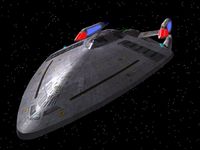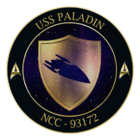Prometheus Design History
| USS Paladin | ||
|---|---|---|
 INACTIVE STATUS | ||
| ||
After the first major encounter between the Dominion and the Federation at the end of 2370. Starfleet responded to the new threat by reactivating the Defiant project and continuing development of the Sovereign project. However, it was felt that further action was needed; the Sovereign class ships were relatively resource intensive, and while the Defiants were easy to build they were also rather limited on range and endurance. It was decided to combine various technologies into the new ship. The ablative armour and quantum torpedoes which equipped the Defiant and Sovereign classes were included, as were the advanced hull geometry and warp field technology of the Sovereign and Intrepid classes.
Starfleet also decided to incorporate the separation concept into the new vessel. Many Starfleet ships have had the ability to separate their primary hull from the rest of the ship, but this has historically been an emergency measure intended to allow the engineering hull to be abandoned in the event that a warp core breach is imminent. Reconnection has generally required the services of a starbase of drydock in a process which takes several days.
With the Galaxy class, Starfleet took the separation process a step further. The primary and engineering hulls both had impulse engine systems, allowing them to operate as fully equipped slower-than-light (STL) spacecraft in their own right. The engineering hull was able to use its warp drive whilst separated, not simply as an emergency measure for a few seconds or minutes but as a viable interstellar drive system. The intent was to allow the primary hull to escape a combat area with the civilians and family members whilst the engineering hull kept the enemy occupied.
However, this concept was never really as successful as Starfleet wanted. The primary hull was essentially stationary by warp drive standards, making it an easy target for an enemy which defeated the engineering hull in battle. What was needed was a ship which could split into multiple sections, each capable of independent warp speed travel. This is the technology Starfleet decided to incorporate into the new Prometheus class.
The ship which emerged from the drawing boards was capable of separating into three sections - the upper and lower engineering hulls and the saucer section. Both parts of the engineering hull had two nacelles whilst the saucer section had a small auxiliary unit which would deploy once separated.
The warp core arrangement was also unique. The efficiency of a warp core is, in part, dependent on its height - the longer a core is, the more accurately the matter and antimatter streams can be controlled. Starfleet had initially wanted to equip each section of the Prometheus design with a Defiant-style warp core. This is very compact at only three decks tall, but suffers from inefficiency as a result. It overcomes this by using multiple matter and antimatter streams, so achieving high fuel throughput and so high power output. This gives the core a very high fuel consumption, something considered acceptable for the short range Defiant but not for the Prometheus.
To solve the problem the designers came up with a unique core design for the engineering hull. The warp core has no less than three reaction chambers along its height. During normal operation matter is fed in at the top of the core and antimatter at the bottom, as in any normal warp core. The fuel streams pass directly through the upper and lower reaction chambers and continue down to their meeting point in the central chamber. The core thus operates in a manner similar to any standard model, achieving high efficiency through the long core design.
The central reaction chamber lies on the separation plane, and once the ship splits it is shut down. In the lower engineering section a secondary matter feed just under the central chamber comes into operation, feeding deuterium down to the lower reaction core. This process is mirrored in the upper engineering section, with an antimatter feed sending fuel up to the upper core.
As a result, the combined engineering sections can operate at an efficiency level comparable to any contemporary starship, while the separated sections loose a measure of efficiency because of the shorter warp cores. The primary hull operates on a separate Defiant-style warp core when separated.
The original intent was to have the saucer serve to evacuate civilians as in the Galaxy class, but at warp speed. The idea of carrying civilians was quickly abandoned, however, and the saucer section up-gunned to match the remainder of the vessel. In separated mode the ship is thus able to attack on enemy from three different directions simultaneously, a tactic known as "multi-vector assault mode".
The development and construction of the prototype vessel took three years, and the USS Prometheus was launched in April of 2374. Initial trials went well, but during the shakedown cruise the Prometheus was stolen by Romulan operatives intent on handing the ship over to the Tal Shiar. The power of the Prometheus was graphically demonstrated during the incident. Although the prototype was still in the test phase, she was able to inflict devastating damage on a Nebula class ship and withstand a combined attack by two Defiant class Escort vessels and an Akira class cruiser. In the same battle she used multi-vector assault mode to destroy a Romulan Warbird with ease. The ship was eventually recovered with the assistance of two EMH units on board, and after some assessment of the project's security procedures the testing resumed.
The performance of the Prometheus during this accidental live-fire trial has exceeded all expectations for the ship. The ability to pack firepower little short of a Sovereign class into a ship the size of an Intrepid class offers the prospect of a prodigious increase in Starfleet's potential combat capability.
Five Prometheus class ships have been built to date, including: NX-Prometheus, USS Caledonia, and the USS Paladin. Two more ships are yet to be commissioned.
